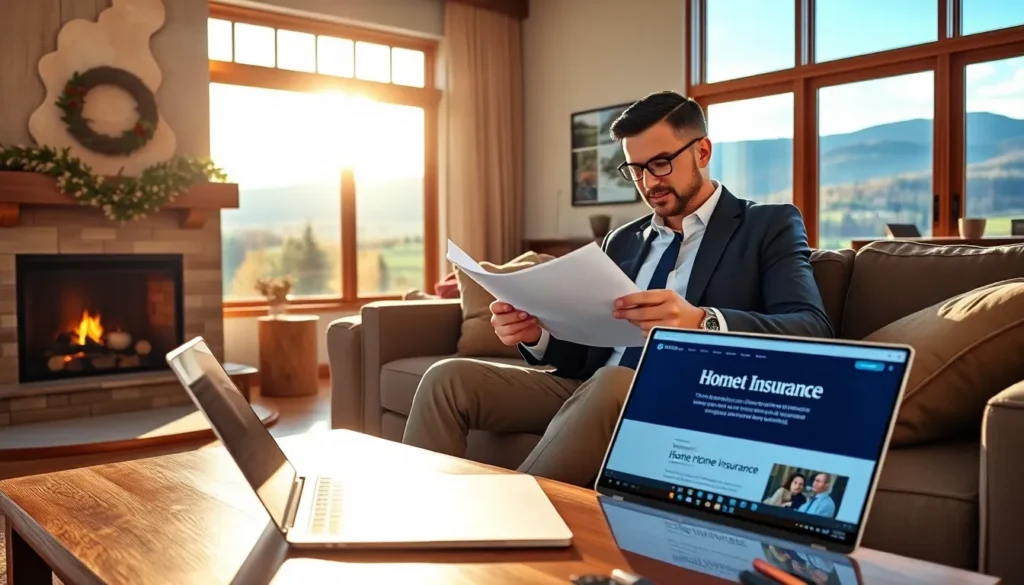Imagine trying to cozy up by your fireplace, only to find a tree has decided to crash onto your roof. Now, that’s a story for the neighbors. Thankfully, a solid Vermont home insurance policy can help protect you from those unforeseen mishaps. Vermont, with its stunning landscapes and charming communities, also brings unique insurance needs. This guide dives deeply into the nuances of home insurance in the Green Mountain State, ensuring homeowners are well-prepared and informed. It’s time to get to know your options, understand coverage, and maybe even save some money along the way.
Table of Contents
ToggleUnderstanding Home Insurance in Vermont

Home insurance isn’t just a safety net: it’s a lifeline for homeowners in Vermont. The state, known for its picturesque barns and snowy winters, presents specific risks that insurance must address. Homeowners often wonder what exactly this coverage entails. Essentially, it protects against damages to the structure and belongings due to events like fire, theft, or natural disasters. In Vermont, where the weather can be a bit unpredictable, having a robust insurance policy can make a world of difference.
Also, many policies offer liability protection, which is vital in case someone gets injured on your property. It’s good to remember that having this coverage isn’t just about being smart: it’s about safeguarding a hefty investment, your home. That way, if Mother Nature decides to crank up her fury, you’re not left holding the bill.
Types of Home Insurance Policies Available
When it comes to home insurance policies in Vermont, variety reigns. Homeowners typically have several options tailored to their specific needs.
- HO-1 Basic Form Policy: This is a minimal coverage option, usually not widely recommended because it covers only a few specifically named perils.
- HO-2 Broad Form Policy: It extends coverage to additional risks, protecting both the home and personal property from certain incidents.
- HO-3 Special Form Policy: The most common policy, HO-3 covers all perils not explicitly excluded in the policy, making it a prime choice for homeowners.
- HO-4 Renters Insurance: Great for those who don’t own their home but still need protection for personal belongings.
- HO-6 Condo Insurance: This one caters specifically to condo owners. It covers personal property along with structural components that the condo association doesn’t insure.
Each policy type has its own unique benefits. Homeowners should evaluate what coverage best suits their personal situations and mitigate risks associated with living in Vermont.
Factors Influencing Home Insurance Rates in Vermont
Home insurance rates in Vermont can fluctuate based on a variety of factors. Understanding these can help homeowners make informed financial decisions.
- Location: Homes situated in areas prone to flooding or other natural disasters may see higher premiums.
- Age and Condition: Older homes, while full of charm, often come with higher repair costs, influencing insurance rates.
- Deductibles: Opting for a higher deductible can lower monthly premiums. It’s crucial to weigh this decision carefully.
- Credit Score: Insurance companies often factor in a homeowner’s credit score. A higher score could lead to reduced rates.
- Home Security: Installing security systems can yield discounts, as they lessen the risk of theft or damage.
It’s important for homeowners to assess these factors periodically, as they can change over time and influence overall costs significantly.
Required Coverages for Homeowners in Vermont
While homeowners in Vermont have the flexibility to choose their coverage, certain types are essential.
- Dwelling Coverage: This is the heart of any home insurance policy. It pays for repairs or replacement if the house is damaged.
- Personal Property Coverage: If your belongings are damaged or stolen, this coverage steps in to help. It can include furniture, electronics, and clothing.
- Liability Coverage: Crucial for protecting against lawsuits, this coverage applies if someone gets injured on your property.
- Additional Living Expenses: Should disaster strike and your home becomes unlivable, this coverage offers financial assistance for temporary living arrangements.
Vermont homeowners should consult with their insurance agents to ensure these basics are included in their policies. It’s just like having an umbrella on a cloudy day, it pays to be prepared.
How to Choose the Right Home Insurance Provider
Choosing the right home insurance provider can feel like a challenging job, but it doesn’t have to be. Begin by researching the credibility and ratings of different insurance companies. Reviews from peers can provide invaluable insights.
Next, consider what they offer in terms of coverage. Does the provider allow customization of policies? It’s crucial to ensure that your specific needs are met rather than a one-size-fits-all approach.
Also, don’t shy away from asking for quotes from multiple providers. Comparing prices and offerings can reveal the best options at reasonable rates.
Evaluate customer service by contacting them with questions. A responsive and helpful customer service team can make all the difference when navigating claims and coverage details.
Eventually, the right provider will not only offer competitive rates but also stand out through dedicated support and solid coverage options.
Tips for Saving on Home Insurance in Vermont
Saving on home insurance in Vermont might feel challenging, but it’s entirely achievable. Here are some practical tips homeowners can consider:
- Bundle Policies: Often, combining home and auto insurance with the same provider leads to discounts.
- Update Safety Features: By installing smoke detectors, alarms, or security systems, homeowners can qualify for lower rates.
- Shop Around: Markets change. Regularly checking for better rates or coverage options can lead to savings.
- Maintain Good Credit: As mentioned earlier, a healthier credit score translates to favorable rates.
- Review Your Coverage: Don’t pay for coverage you don’t need. Regularly reassessing your policy allows you to eliminate unnecessary expenses.
Vermont residents can use these strategies to ensure they are not overspending on their insurance while still being adequately protected.



